 |
This fascmile is from the
Pancha-siddhantika (Five Principles)
dated
around the 5th century.
This text graphically shows
how eclipses are to be
calculated.
Thus this text foreshadows
what Westeren Astronomers
propounded
nearly one thousand years later |
Indian Astronomy-Astronomy started from ancient India per vedic texts ,millions of years ago(not 5000 years ago)These are called religious texts by poor evengelist westerners but they have science as you see in my all posts here. Indian Panchang is able to foretell about Sun and Moon eclipse without looking at them directly because there is connection between all elments including different SUNS , all moons and many earths and it is math. Pl see my other posts about Indian Sacred Math, that was called Arabian Math as westerners came to India after Islamist came in ~780 years ago and destructed and changed many temples to barbaric Mosque. Even Qutum Minar, was a astronomical place called Dhruv Stamph and used for astronomy purpose but these Islamist Rascals destructed and put their name on that.Link here.
In the Veda texts, the
noble men were called Devas,(IT IS NOT USED FOR GOD as many sites tell you)And bad people were namedd Asuras and Melicha. The Sun, comets, the sky, dawn, and the horizon were all
deified based on their attributes. A beautiful verse from a Veda mentioning about SUN is here-
'Thou art a blessing
when thou art near
Raise up wealth to the worshipper, thou mighty
Dawn
Shine for us with thy best rays, thou bright Dawn
Thou daughter of
the sky, thou high-born Dawn.'
The earliest Veda text
mentioning astronomy is called the Rig Veda, and was written millions of years ago not 2000-5000 BC as historians misguide it.
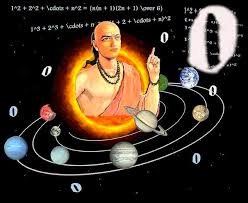 Indian astronomers recognized like Aryabhata,Varahamihira, Brahmagupta , that the stars are the same as the Sun, only
farther away. Verses mention that the night sky has uncountable suns. This is an
incredible scientific leap which Vedas knew millions of years ago before westernes found out and still struggling to say that. Rigvedas refer that Sun not Earth was center of our Sun Universe. Ypu all know how christian evengelist blinded eyess of Galleo when he quoted that just few hundred years ago.
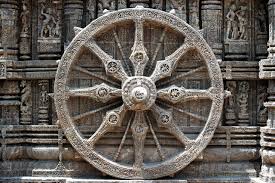  The Rigveda shows that the Indians divided the year into 360 days, and the year was subdivided into 12 months of 30 days. Every 5 years, two intercalary periods were added to bring the calendar back in line with the solar year, ensuring that years averaged 366 days. However, the Indian year still migrated four days in every five years, and Indian astronomers constantly tweaked and adjusted their calendars over the millennia. The text also shows that the Indians used four cardinal points for ensuring the correct orientation of altars.

The Jyotisa Vedanga, the first Vedic text to mention astronomical data, records events going back as far as 4000 BCE, although many archaeoastronomers believe that this text may include observations from as early as 11 000 BCE. They point out that some of the records may have been copied from earlier manuscripts, but this is an area where more research is needed, as many of the references are unclear and couched in religious terminology.
In the 5th century, a
great Indian astronomer and mathematician named Aryabhatta advanced this
heliocentric theory and also discussed his idea that the Sun is the source of
moonlight. He also studied how to forecast eclipses. His books
and others were translated into Latin in the 13th century, and profoundly
influenced European mathematicians and astronomers, who stole Indian astronomy and put their nameLINK.
 Several Indian
scientists of the 6th century also were the first to advance the idea of
gravity. They noticed that a special force keeps objects stuck to the earth, and
hypothesized that the same force might be responsible for holding heavenly
bodies in their place. The idea pre-dates Newton's conception of gravity by
about 1100 years. GRAVITY WAS DISCOVERED BY INDIANS NOT NEWTON. Several Indian
scientists of the 6th century also were the first to advance the idea of
gravity. They noticed that a special force keeps objects stuck to the earth, and
hypothesized that the same force might be responsible for holding heavenly
bodies in their place. The idea pre-dates Newton's conception of gravity by
about 1100 years. GRAVITY WAS DISCOVERED BY INDIANS NOT NEWTON.
Following is summary of Indian ASTRONOMY-
-
The
calculation of occurrences of eclipses
-
-
-
-
 There are
astronomical references of chronological significance in the Vedas. Some Vedic
notices mark the beginning of the year and that of the vernal equinox in Orion;
this was the case around 4500 BC. Fire altars, with astronomical basis, have
been found in the third millennium cities of India. The texts that describe
their designs are conservatively dated to the first millennium BC, but their
contents appear to be much older. There are
astronomical references of chronological significance in the Vedas. Some Vedic
notices mark the beginning of the year and that of the vernal equinox in Orion;
this was the case around 4500 BC. Fire altars, with astronomical basis, have
been found in the third millennium cities of India. The texts that describe
their designs are conservatively dated to the first millennium BC, but their
contents appear to be much older.
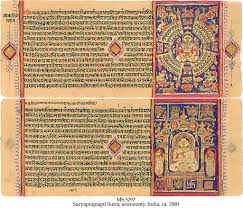  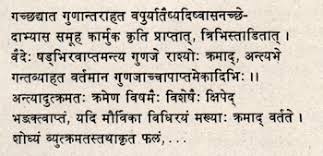 Some
scholars have claimed that the Babylonians invented the zodiac of 360 degrees
around 700 BCE, perhaps even earlier. Many claim that India received the
knowledge of the zodiac from Babylonia or even later from Greece. However, as
old as the Rig Veda, the oldest Vedic text, there are clear references to a
chakra or wheel of 360 spokes placed in the sky. The number 360 and its related
numbers like 12, 24, 36, 48, 60, 72, 108, 432 and 720 occur commonly in Vedic
symbolism. It is in the hymns of the great
Rishi Dirghatamas (RV I.140 – 164) that we have the clearest such
references. Some
scholars have claimed that the Babylonians invented the zodiac of 360 degrees
around 700 BCE, perhaps even earlier. Many claim that India received the
knowledge of the zodiac from Babylonia or even later from Greece. However, as
old as the Rig Veda, the oldest Vedic text, there are clear references to a
chakra or wheel of 360 spokes placed in the sky. The number 360 and its related
numbers like 12, 24, 36, 48, 60, 72, 108, 432 and 720 occur commonly in Vedic
symbolism. It is in the hymns of the great
Rishi Dirghatamas (RV I.140 – 164) that we have the clearest such
references.
The
earliest concept of a heliocentric model of the
solar
system, in which the Sun that is at the centre of the solar system and the
Earth that is orbiting it, is found in several Vedic Sanskrit texts
written in ancient
India.
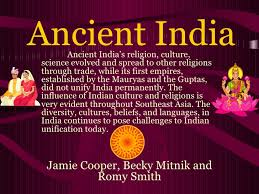 The Aitareya Brahmana
(2.7) (c. 9th–8th century BC) states: "The Sun never sets nor rises. When
people think the sun is setting, it is not so; they are mistaken." This
indicates that the Sun is stationery (hence the Earth is moving around it),
which is elaborated in a later commentary Vishnu Purana (2.8)
(c. 1st
century), which states: "The sun is stationed for all time, in the middle
of the day. [...] Of the sun, which is always in one and the same place, there
is neither setting nor rising." The Aitareya Brahmana
(2.7) (c. 9th–8th century BC) states: "The Sun never sets nor rises. When
people think the sun is setting, it is not so; they are mistaken." This
indicates that the Sun is stationery (hence the Earth is moving around it),
which is elaborated in a later commentary Vishnu Purana (2.8)
(c. 1st
century), which states: "The sun is stationed for all time, in the middle
of the day. [...] Of the sun, which is always in one and the same place, there
is neither setting nor rising."
 Yajnavalkya (c. 9th–8th
century BC) recognized that the Earth was round and believed that the Sun
was "the centre of the spheres" as described in the Vedas at the time. His
astronomical text Shatapatha
Brahmana (8.7.3.10) stated: "The sun strings these worlds - the
earth, the planets, the atmosphere - to himself on a thread." He recognized
that the Sun was much larger than the Earth, which would have influenced this
early heliocentric concept. He also accurately measured the relative distances
of the Sun and the Moon from the Earth as 108 times the diameters of these
heavenly bodies, almost close to the modern measurements of 107.6 for the Sun
and 110.6 for the Moon. Yajnavalkya (c. 9th–8th
century BC) recognized that the Earth was round and believed that the Sun
was "the centre of the spheres" as described in the Vedas at the time. His
astronomical text Shatapatha
Brahmana (8.7.3.10) stated: "The sun strings these worlds - the
earth, the planets, the atmosphere - to himself on a thread." He recognized
that the Sun was much larger than the Earth, which would have influenced this
early heliocentric concept. He also accurately measured the relative distances
of the Sun and the Moon from the Earth as 108 times the diameters of these
heavenly bodies, almost close to the modern measurements of 107.6 for the Sun
and 110.6 for the Moon.
Based on
his heliocentric model, Yajnavalkya proposed a 95-year cycle to synchronize the
motions of the Sun and the Moon, which gives the average length of the tropical
year as 365.24675 days, which is only 6 minutes longer than the modern value
of 365.24220 days. This estimate for the length of the tropical year remained the
most accurate anywhere in the world for over a thousand years. The distances of
the Moon and the Sun from the Earth was accurately measured as 108 times the
diameters of these heavenly bodies. These are very close to the modern values of
110.6 for the Moon and 107.6 for the Sun, which were obtained using modern
instruments.
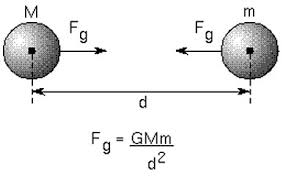  There is
an old Sanskrit shloka (couplet) which also
states "Sarva Dishanaam, Suryaha, Suryaha, Suryaha" which means that there are
suns in all directions. This couplet which describes the night sky as full of
suns, indicates that in ancient times Indian astronomers had arrived at the
important discovery that the stars visible at night are similar to the Sun
visible during day time. In other words, it was recognized that the sun is also
a star, though the nearest one. This understanding is demonstrated in another
Sloka which says that when one sun sinks below the horizon, a thousand suns take
its place. There is
an old Sanskrit shloka (couplet) which also
states "Sarva Dishanaam, Suryaha, Suryaha, Suryaha" which means that there are
suns in all directions. This couplet which describes the night sky as full of
suns, indicates that in ancient times Indian astronomers had arrived at the
important discovery that the stars visible at night are similar to the Sun
visible during day time. In other words, it was recognized that the sun is also
a star, though the nearest one. This understanding is demonstrated in another
Sloka which says that when one sun sinks below the horizon, a thousand suns take
its place.

Many
Indian astronomers had later formulated ideas about gravity and gravitation in
the early middle ages.
 The
cosmological time cycles explained in the Surya Siddhanta,
which was copied from an earlier work, gives: The
cosmological time cycles explained in the Surya Siddhanta,
which was copied from an earlier work, gives:

The
average length of the sidereal year (the length
of the Earth's revolution around the Sun) as 365.2563627 days, which is only 1.4
seconds longer than the modern value of 365.2563627 days. This remained the most
accurate estimate for the length of the sidereal year anywhere in the world for
over a thousand years.

The
average length of the tropical year (the length
of the year as observed on Earth) as 365.2421756 days, which is only 2 seconds
shorter than the modern value of 365.2421988 days. This estimate remained the
most accurate estimate for the length of the tropical year anywhere in the world
for another 6 centuries (until Muslim mathematician
Omar
Khayyam gave a better estimate), and still remains more accurate than the
value given by the modern Gregorian calendar
currently in use around the world, which gives the average length of the year as 365.2425 days. in use around the world, which gives the average length of the year as 365.2425 days.
Later
Indian astronomer-mathematicians such as Aryabhata made references to
this text, while later Arabic and Latin translations were very
influential in Europe and the Middle East.
The Indian
astronomer-mathematician Aryabhata (476–550), in his magnum opus
Aryabhatiya, propounded a mathematical heliocentric model in which the
Earth was taken to be spinning on its axis and the periods of the planets were
given with respect to a stationary Sun. He was also the first to discover that
the light from the Moon and the planets were reflected from the Sun, and that
the planets follow an elliptical orbit around the Sun,
and thus propunded an eccentric elliptical model of
the planets, on which he accurately calculated many astronomical constants, such
as the times of the solar and lunar eclipses, and the instantaneous
motion of the Moon (expressed as a differential
equation). Bhaskara (1114-1185) expanded on Aryabhata's
heliocentric model in his treatise Siddhanta-Shiromani, where he
mentioned the law of gravity, discovered that the
planets don't orbit the Sun at a uniform velocity, and accurately
calculated many astronomical constants based on this model, such as the solar
and lunar eclipses, and the velocities and instantaneous motions of the planets.
Arabic
translations of Aryabhata's Aryabhatiya were available from the 8th
century, while Latin translations were available
from the 13th century, before
Copernicus had written De revolutionibus orbium coelestium, so it's quite
likely that Aryabhata's work had an influence on Copernicus'
ideas.
 Aryabhata
wrote that 1,582,237,500 rotations of the Earth equal 57,753,336 lunar orbits.
This is an extremely accurate ratio of a fundamental astronomical ratio
(1,582,237,500/57,753,336 = 27.3964693572), and is perhaps the oldest
astronomical constant calculated to such accuracy. Aryabhata
wrote that 1,582,237,500 rotations of the Earth equal 57,753,336 lunar orbits.
This is an extremely accurate ratio of a fundamental astronomical ratio
(1,582,237,500/57,753,336 = 27.3964693572), and is perhaps the oldest
astronomical constant calculated to such accuracy.
Bhaskara (1114-1185) was the head of the
astronomical observatory at Ujjain, continuing the mathematical tradition of
Brahmagupta. He wrote the Siddhanta-Shiromani which consists of two
parts: Goladhyaya (sphere) and Grahaganita (mathematics of the
planets).
"In India I found a race of mortals
living upon the Earth. but not
adhering to it.
Inhabiting cities, but not being fixed to them,
possessing everything but possessed by nothing".
- Apollonius Tyanaeus
- Greek Thinker and Traveller 1st Century AD
  Mayan Astronomy- Mayan Astronomy- Mayanas used astronomy for agriculture purpose, although they did not invent any clock but their mayan calender has many animlas, celestial events and they go by that. What it means is that they were well worsed with universe of stars,probably learned from Indian, their roots. If you look at Indian and Mayan calender- they look a like.
 Mayan cosmology is well described in this article Mesoamerican astronomy (see references). Earth is in layer one of upper world in the center of universe. And there is underworld(PATAL LOKA as in Indian scriptures) .It is shown a
large wheel surrounded by the teoatl,( divine water), -or ocean
that extends to the horizon. Layer 2 is Ilhuicatl metzli,,place for moon and clouds. Layer 3 is Citlalco, associated with deity Citlallicue ("She of the Starry
Skirts"). Layer 4 is called Ilhuicatl Tonatiuh is SUN.Fifth layer is Venus, the "Great Star. 6 th layer is is Ilhuicatl Mamalhuazocan, ("Heaven of the Fire Drill,)" a constellation ? Orion's .Comets("Smoking Stars come in to this layer ,as they say "fire serpents
attend to their duty of bringing the sun from the east to west". 7 th layer is called Blue or Black Heavens. with winds / storms. 8 th layer is is blue heaven, covered with dusts. 8th layer is , Itztapal Nanatzcayan(home of thunder) - "Where Stone Slabs Crash
Together." 10 th layer is white ,.Layer 11 is yellow.Layer12 is red. Layer 13 is Omeyocan, is
a place for a dual male-female god(ARDHNARISWAR AS IN INDIAN SCRIPTURE), that created space and time,lives (matter).
The Milky Way was
seen as umbilical cord ,to connect soul to underworld. Michael Coe
states, "The Mesoamerican cosmos was one in constant flux, in which space and
time were co-terminous, in which the heavenly bodies moved in fixed layers, and
which was in constant peril of cataclysm".
Tonatiuh, a red eagle with a large and all-seeing eye, was the god
associated with the sun. Mayan knew that tilt of the Earth's axis, is reason for sun's appearance at different positions in the sky depending on the time of year and responsible for seasons. The Maya accurately
calculated times when the sun would rise and set, and even more amazing, they
determined the length of the solar year to be 365 days. A tropical year is
365.2422 days ,small error though. This was updated
continuously throughout the generations.
The moon was represented by a female deity with effect on terrestrial events. A Mayan astronomer calculated that there were exactly 149 moons over a period of
4400 days, which works out to an average lunation of 29.53 days. In the city of
Palenque, it was found that there are 405 moons in 11,960 days, which means that
an average lunation is 29.53086 days. This is remarkable accuracy, given that
the actual average lunation is 29.53059 days.
Venus was connected with the
major deity Quetzalcoatl.,called Xux Ek, the "Great Star,".Mayans
knew that it is the same object seen both in morning and the evening
at different times of the year. The priest-astronomers determined the synodic
period of Venus (how long it takes to orbit the sun) to be 584 days, which is
again incredibly close to the actual period of 583.92 days. When Venus rose in
the mornings, it was considered bad luck, and everyone would stay inside their
homes and block their chimneys so that the evil light from Venus could not
enter.
The Mayans also calculated the synodic periods of Mars as 780 days
(actual = 779.936 days) and Mercury as 117 days (actual = 116 days).
Mayans did not have interest in Jupiter and Saturn.
Pleiades star cluster was known as tianquiztli, (marketplace), that appears in the morning sky around planting time, in late
April. This helped for sowing season ahead . Polaris, or
Xaman Ek, was used by travelers to orient themselves on land.
Comets were believed to be an even more direct link to the human world. If a
comet, or "star that smokes," appeared in the sky, it foretold the death of a
noble person.
 Maya
priest-astronomers knew that sun and moon crosses each other' path every 173.31 days. and eclipses may occur within
18 days this period. Look at this eclipse table resides in the Dresden
Codex, which was written in the eleventh century in the northern Yucatan. The
codex is made of ficus tree bark, and the pages are covered with lime for a
glossy finish. The glyphs are painted in red and black with a very fine brush.
In the eclipse section of the Dresden Codex, two numbers appear quite
frequently. The numbers 177, which is approximately the length of six lunations,
and 148, or five lunations, are representative of times when eclipses were
predicted. The astronomers periodically corrected the eclipse tables, learning
from their small mistakes and adjusting the calendars, and so on several
occasions we see that the number 178 appears in place of 177. In effect, the
eclipse tables consist of columns and rows of the numbers explained above, and
in some cases, the eclipse glyph is presented instead. This symbolizes days when
an eclipse could be expected, and if one did occur, the number was replaced by
the eclipse glyph. Maya
priest-astronomers knew that sun and moon crosses each other' path every 173.31 days. and eclipses may occur within
18 days this period. Look at this eclipse table resides in the Dresden
Codex, which was written in the eleventh century in the northern Yucatan. The
codex is made of ficus tree bark, and the pages are covered with lime for a
glossy finish. The glyphs are painted in red and black with a very fine brush.
In the eclipse section of the Dresden Codex, two numbers appear quite
frequently. The numbers 177, which is approximately the length of six lunations,
and 148, or five lunations, are representative of times when eclipses were
predicted. The astronomers periodically corrected the eclipse tables, learning
from their small mistakes and adjusting the calendars, and so on several
occasions we see that the number 178 appears in place of 177. In effect, the
eclipse tables consist of columns and rows of the numbers explained above, and
in some cases, the eclipse glyph is presented instead. This symbolizes days when
an eclipse could be expected, and if one did occur, the number was replaced by
the eclipse glyph.
Mayan Mathematics
The Maya mathematical
system were a copy of Indian math system with numbers and while Europe had dark age
Mayan system were playing with numbers,vigesimal, or base 20, number system. Mayan numbers consist of a series of dots and
bars, where dots have a value of one and bars represent five. The numbers one
through nineteen, and a series of glyphs representing the number zero, are shown
in the picture below. Remember ZERO was used by Aryabhatta in India >2000-5000 yrs BC.
 The Mayan system operated on exactly the same principles,what is used now a decimel using 1o while Mayans were using 20's in place of 10's. i.e. 1; 20; 400; 8000; 160000. An
example of simple addition of a large number is shown in the figure below . The
Maya also COPIED the concept of zero, FROM INDIANS which had immense benefit as a
place-holder and vastly simplified basic arithmetic, along with making it
possible to do more complex calculations. Western archeologist and mathmatecian still will say That Mayan used Zero before Indians but it is again a history they want to hide from all and trying to proove Indians as sheep dwellers,which is debunked now. The Mayan system operated on exactly the same principles,what is used now a decimel using 1o while Mayans were using 20's in place of 10's. i.e. 1; 20; 400; 8000; 160000. An
example of simple addition of a large number is shown in the figure below . The
Maya also COPIED the concept of zero, FROM INDIANS which had immense benefit as a
place-holder and vastly simplified basic arithmetic, along with making it
possible to do more complex calculations. Western archeologist and mathmatecian still will say That Mayan used Zero before Indians but it is again a history they want to hide from all and trying to proove Indians as sheep dwellers,which is debunked now.
The Mayan Calendar
Mayan mathematical system was in the development of
their Indian counterpart and were as good as Ancient Indians. They had different calenders,one for RITUALS-consisted of thirteen 20-day periods, which totaled 260 days. Although
it is unclear exactly why the Maya chose a 260-day calendar, there are several
theories. First, the numbers 13 and 20 were two of the numbers considered to
have magical powers. Second, by coincidence, two ritual calendar years (520
days) is the same as 3 eclipse half-years (520 days). Finally, although this is
a controversial idea, 260 days is approximately the length of human gestation
(266 days). It seems likely that a combination of these factors influenced the
creation of the 260-day ritual calendar. Each day in a 20-month period of the
ritual calendar is represented by a specific animal, plant, or natural force.
Other calender was Solar calendar, was 365 days
long, consisting of eighteen 20-day periods plus a final five "days without
name.
|
|
|
 Alignment of Mayan Buildings and Temples Alignment of Mayan Buildings and Temples
Archeologist like Aveni think that Mayan Temples were of significant astronomical event based as in Indian counterparts(see references).For example ,look at this Building J at Monte Alban, which was
built around 275 B.C.E. This building was constructed in an arrow shape, and
Aveni found that five of the brightest stars in the sky would at that time have
set approximately at the point of the arrow. In addition, a line drawn
perpendicular to the front steps of the building would have pointed directly to
the place on the horizon at which the bright star Capella rose. By coincidence,
it seems that the appearance of Capella at this position could have heralded the
passage of the sun through the zenith (the point directly overhead), since at
Monte Alban these events are almost simultaneous. Evidence of this appears in
the presence of a zenith tube at the same site, which points directly overhead
and effectively finds the sun's zenith passage.
Mayans had temples built basically works as observatories that had special viewing windows set into the walls (Like counter parts in Indian temples -link
Astronomy of Incas-There was a King, military king Pachacuti Inca Yupanqui that brought
South America united, after demise of Huari and
Tiwanaku cultures.It was centered near city of Cuzco in the Andes Mountains, over 375,000 square
miles. The society was very organized, like Harrapan in India,with laws and demarcation of
classes.
 Like Ancient Egypt and India, there Astronomy was basically for agriculture purpose like when
Pleiades star cluster rose, it signaled the start of the Incan year. The
Pleiades were called the Seven Kids after the seven brightest stars in the
cluster, but the Inca were able to see 13 stars.
Astronomy was used extensively for
agricultural purposes. The Inca built carefully oriented pillars on hills
overlooking Cuzco, and when the Sun rose or set between the pillars, it was time
to plant at a specific altitude. A whole range of pillars was employed so that
the most accurate time-keeping was possible for the high altitudes, the valley
floor, and everywhere in between..
Egyptian Astronomy-
 The Egyptian gods and goddesses were
numerous before Islamic terrorism as in India. Certain gods were seen
in the constellations, and others were represented by actual astronomical
bodies(LIKE IN MAYAN AND INDIAN). The constellation Orion, for instance, represented Osiris, who was the
god of death, rebirth, and the afterlife. The Milky Way represented the sky
goddess Nut giving birth to the sun god Ra. In the picture below, Nut is shown
bending over the Egyptians. The stars in Egyptian mythology were represented by
the goddess of writing, Seshat, while the Moon was either Thoth, the god of
wisdom and writing, or Khons, a child moon god. Egyptians and infact all mediterranians were part of Ancient Indian extension untill 1000 years ago- islamic terrorism came and made them STUPID MULLAH.Click for link .They were worshippers of SUN god like Indians. The Egyptian gods and goddesses were
numerous before Islamic terrorism as in India. Certain gods were seen
in the constellations, and others were represented by actual astronomical
bodies(LIKE IN MAYAN AND INDIAN). The constellation Orion, for instance, represented Osiris, who was the
god of death, rebirth, and the afterlife. The Milky Way represented the sky
goddess Nut giving birth to the sun god Ra. In the picture below, Nut is shown
bending over the Egyptians. The stars in Egyptian mythology were represented by
the goddess of writing, Seshat, while the Moon was either Thoth, the god of
wisdom and writing, or Khons, a child moon god. Egyptians and infact all mediterranians were part of Ancient Indian extension untill 1000 years ago- islamic terrorism came and made them STUPID MULLAH.Click for link .They were worshippers of SUN god like Indians.
Chinese astronomy-
Chinese used extensive system of the zodiac designed to help
guide the life of people on Earth. called
'yellow path', a reference to the sun traveling along the ecliptic. Like in
Western astrology, the Chinese had twelve houses along the yellow path.
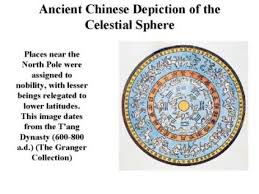 The first Chinese written records of
astronomy are from about 3000 B.C. The first human record of an eclipse was made
in 2136 B.C., and over hundreds of years of advanced sky-watching, the Chinese
became very adept at predicting lunar eclipses. They followed a calendar of
twelve lunar months, and calculated the year to be 365.25 days long. They
translated this 'magic' number into a unit of degrees, by setting the number of
degrees in a circle equal to 365.25 (as compared to our use of 360 degrees). The first Chinese written records of
astronomy are from about 3000 B.C. The first human record of an eclipse was made
in 2136 B.C., and over hundreds of years of advanced sky-watching, the Chinese
became very adept at predicting lunar eclipses. They followed a calendar of
twelve lunar months, and calculated the year to be 365.25 days long. They
translated this 'magic' number into a unit of degrees, by setting the number of
degrees in a circle equal to 365.25 (as compared to our use of 360 degrees).
One of the famous observations made by
Chinese astronomers was that of a supernova in the year 1054. They referred to
this phenomenon in records as a 'guest star', and mention that it remained
bright for about a year before again becoming invisible. This supernova created
what we see today as the Crab Nebula. The explosion itself in 1054 was also
recorded by the Anasazi Indians of the American Southwest, but for some reason
there is no known record of this occurance in European or any other cultures.
In order to mark the passage of time and the
seasons, the Chinese primarily used the orientation of the Big Dipper
constellation relative to the pole star in early evening. They were also the
inventors of the first clock, a water clock which divided a day into 100 equal
parts. During the Ming Dynasty, between the years of 1436-1449, an observatory
was built in Beijing on the old city walls, and was filled with impressive
bronze instruments.
Astronomy of Ancient North Americans- So called Red Indian Tribes by British were in fact well versed in Astronomy.
The Anasazi of Chaco
Canyon, New Mexico
 The Anasazi were mysterious people,
lived in Arizona and New Mexico about 1000 years ago. They built high
cliff dwellings, the ruins can be seen today. They left little to decipher but a recently discovered site Penasco Blanco depicts supernova explosion (see picture below). The relative
orientations of the crescent moon and the star make it very likely that this is
a recording of the supernova which created the Crab Nebula in 1054 A.D. This
supernova, which would have been about five times brighter than Venus for about
three weeks, was also recorded by Chinese astronomers. Another very interesting
site is called the Anasazi sun dagger. It is a spiral design traced into a cave
wall, and during midsummer, midwinter, and the equinoxes it is perfectly
bisected or surrounded by daggers of sunlight which enter the specially placed
windows. The Anasazi also built a solar observatory called Hovenweep Castle at
Four Corners. All of this evidence points to the fact that the Anasazi were
quite experienced sky-watchers, as are their probable descendents, the Pueblo
Indians. The Anasazi were mysterious people,
lived in Arizona and New Mexico about 1000 years ago. They built high
cliff dwellings, the ruins can be seen today. They left little to decipher but a recently discovered site Penasco Blanco depicts supernova explosion (see picture below). The relative
orientations of the crescent moon and the star make it very likely that this is
a recording of the supernova which created the Crab Nebula in 1054 A.D. This
supernova, which would have been about five times brighter than Venus for about
three weeks, was also recorded by Chinese astronomers. Another very interesting
site is called the Anasazi sun dagger. It is a spiral design traced into a cave
wall, and during midsummer, midwinter, and the equinoxes it is perfectly
bisected or surrounded by daggers of sunlight which enter the specially placed
windows. The Anasazi also built a solar observatory called Hovenweep Castle at
Four Corners. All of this evidence points to the fact that the Anasazi were
quite experienced sky-watchers, as are their probable descendents, the Pueblo
Indians.
Big Horn Medicine Wheel,
Wyoming
 The Big Horn Medicine Wheel is a mysterious
stone marking which was placed at the summit of a 10,000 foot mountain between
200-400 years ago, probably by the Cheyenne Indians (see photo ). It has a
diameter of 90 feet, with 28 spokes that radiate outward and apparently stand
for the number of days in a month. Medicine wheel marks both the rising and setting sun on the
summer solstice. Other stones in the arrangement mark the rising of the bright
stars Aldebaran, Rigel, and Sirius. Other medicine wheels have also been found
to have astronomical orientations, such as one at Moose Mountain in Canada,
which was probably built between 100-500 A.D. The Big Horn Medicine Wheel is a mysterious
stone marking which was placed at the summit of a 10,000 foot mountain between
200-400 years ago, probably by the Cheyenne Indians (see photo ). It has a
diameter of 90 feet, with 28 spokes that radiate outward and apparently stand
for the number of days in a month. Medicine wheel marks both the rising and setting sun on the
summer solstice. Other stones in the arrangement mark the rising of the bright
stars Aldebaran, Rigel, and Sirius. Other medicine wheels have also been found
to have astronomical orientations, such as one at Moose Mountain in Canada,
which was probably built between 100-500 A.D.
Pawnee Indians of the
North Central U.S.
 The Skidi band of Pawnee are known to have
had a complex religion of which astronomy was a large part. They designed their lodges and villages
with astronomy in mind(Like Mayan and Indians). Villages were laid out in the position of the most
important stars in the sky. In the last corner of the village was a shrine to
the morning star (Venus), and in the west was another shrine to the evening star
(also Venus). The doors of the lodges always faced east to the rising sun, and
four posts representing the four important directions (northwest, northeast,
southwest, and southeast) were used to hold up the lodge. The domed roof
represented the sky. Part of their creation myth says that Mars, the red morning
star warrior, mated with Venus, the female evening star, to produce the first
humans. They
worshipped the Pleiades cluster. The pole star was considered to be a chief
protecting the stars and the people,make sense as north star is
always up and everything else in the sky revolves around it. The Skidi band of Pawnee are known to have
had a complex religion of which astronomy was a large part. They designed their lodges and villages
with astronomy in mind(Like Mayan and Indians). Villages were laid out in the position of the most
important stars in the sky. In the last corner of the village was a shrine to
the morning star (Venus), and in the west was another shrine to the evening star
(also Venus). The doors of the lodges always faced east to the rising sun, and
four posts representing the four important directions (northwest, northeast,
southwest, and southeast) were used to hold up the lodge. The domed roof
represented the sky. Part of their creation myth says that Mars, the red morning
star warrior, mated with Venus, the female evening star, to produce the first
humans. They
worshipped the Pleiades cluster. The pole star was considered to be a chief
protecting the stars and the people,make sense as north star is
always up and everything else in the sky revolves around it.
Chumash Indians of the
California Coast
The Sun was seen as a widower who carried a torch through the
sky, while the Moon was a female god in charge of human health. The Chumash identified Mars, Jupiter, and Saturn, as well as a
number of stars as dim as sixth magnitude. Their major religious ceremonies took
place around the time of the winter solstice, which was seen as a critical time
during which the Sun might decide not to return. Winter solstice ceremonies were
marked by praying and chanting to pull the Sun back to Earth.
Now with all above description I let reades to decipher how close were Ancient Indian, Mayan, Ancient Agyptian,Ancient Aemerican(red indian). In fact it seems they were one colony untill first Christian gang of conversion started from Rome and converted and destroyed many buildings,terrorized, changed religion to cult and then still followed by islamic terrorism. Pl visit www.shankhnad.org if you want more regarding these topics. Otherwise stay here for more vedic and hinduism science.
|
J. Norman Lockyer, The Dawn of Astronomy,
MIT Press, 1894.
Anthony Aveni. Ancient Astronomers. Smithsonian Books, 1993.
Anthony Aveni. "Astronomy in Ancient Mesoamerica." In In Search of
Ancient Astronomies, edited by E.C. Krupp. Doubleday and Company, 1977. 165-202.
Anthony Aveni. "Possible Astronomical Orientations in Ancient
Mesoamerica." In Archaeoastronomy in Pre-Columbian America, edited by Anthony
Aveni. U. of Texas Press, 1975. 163-190.
Anthony Aveni. Skywatchers of Ancient Mexico. U. of Texas Press,
1980.
Michael Coe. "Native Astronomy in Mesoamerica." In
Archaeoastronomy in Pre-Columbian America, edited by Anthony Aveni. U. of Texas
Press 1975. 3-31.
Evan Hadingham. Early Man and the Cosmos. Walker and Company,
1984.
Guillermo Hinojosa. Personal interview. April 25, 2000.
E.C. Krupp, Echoes of the Ancient Skies: The Astronomy of Lost
Civilizations. Harper and Row, 1983.
Colin A. Ronan. Changing Views of the Universe. MacMillan, 1961.
|
 The literature is full of stories of parallel worlds. For example, the Mahabharata tells the story of how the Naga princess Ulupi abducted Arjuna while he was bathing in the Ganges River .Ulupi pulled Arjuna down not to the riverbed, as we would expect, but into the kingdom of the Nagas (celestial snakelike beings), which exists in another dimension.
The literature is full of stories of parallel worlds. For example, the Mahabharata tells the story of how the Naga princess Ulupi abducted Arjuna while he was bathing in the Ganges River .Ulupi pulled Arjuna down not to the riverbed, as we would expect, but into the kingdom of the Nagas (celestial snakelike beings), which exists in another dimension.

